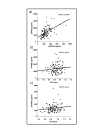Soluble RAGE but not endogenous secretory RAGE is associated with albuminuria in patients with type 2 diabetes
- PMID: 17343760
- PMCID: PMC1821011
- DOI: 10.1186/1475-2840-6-9
Soluble RAGE but not endogenous secretory RAGE is associated with albuminuria in patients with type 2 diabetes
Abstract
Background: Total circulating soluble receptor for advanced glycation endproducts (sRAGE) and a more defined endogenous secretory splice variant of the receptor (esRAGE) were shown to be associated with different markers of cardiovascular risk in patients with diabetes. Since previous data were partly divergent, the aim of this study was to compare sRAGE and esRAGE in a head-to-head analysis in patients with type 2 diabetes (T2DM) with albuminuria.
Methods: sRAGE and esRAGE were studied in plasma of 110 T2DM patients using enzyme-linked immunosorbant assays (ELISA) detecting either sRAGE or esRAGE only. Both sRAGE and esRAGE were compared with regard to applicability as markers for vascular disease and glucose control in T2DM.
Results: In bivariate analysis, sRAGE correlated with age (R = 0.22, p = 0.02) and the 24 hour albumin excretion rate (R = 0.18, p = 0.05), while esRAGE correlated positively with age only (R = 0.23, p = 0.02). In contrast to previous reports, neither sRAGE nor esRAGE correlated with glucose control or intima-media-thickness (IMT) as a predictor of macrovascular disease. In multivariate regression models, the associations between sRAGE and albuminuria as well as esRAGE and age were shown to be independent of glucose control, diabetes duration, body-mass index, glomerular filtration rate, blood pressure and gender.
Conclusion: This is the first study comparing sRAGE and esRAGE as markers of vascular complications in patients with T2DM. sRAGE but not esRAGE is independently associated with albuminuria in these patients while neither sRAGE nor esRAGE are associated with markers of glucose control or macrovascular disease.
Figures
References
-
- Basta G, Sironi AM, Lazzerini G, Del Turco S, Buzzigoli E, Casolaro A, Natali A, Ferrannini E, Gastaldelli A. Circulating soluble receptor for advanced glycation end-products (sRAGE) is inversely associated with glycemic control and S100A12 protein. J Clin Endocrinol Metab. 2006 - PubMed
-
- Katakami N, Matsuhisa M, Kaneto H, Matsuoka TA, Sakamoto K, Nakatani Y, Ohtoshi K, Hayaishi-Okano R, Kosugi K, Hori M, Yamasaki Y. Decreased endogenous secretory advanced glycation end product receptor in type 1 diabetic patients: its possible association with diabetic vascular complications. Diabetes Care. 2005;28:2716–2721. doi: 10.2337/diacare.28.11.2716. - DOI - PubMed
Publication types
MeSH terms
Substances
LinkOut - more resources
Full Text Sources
Other Literature Sources
Medical


